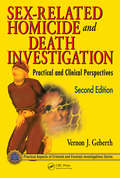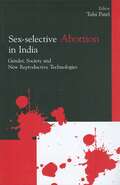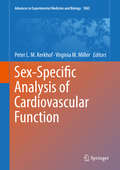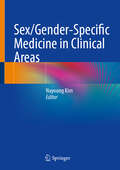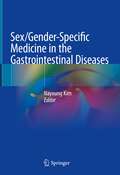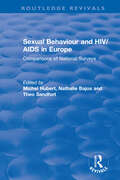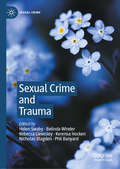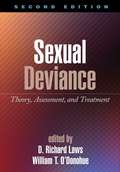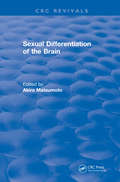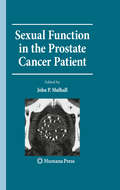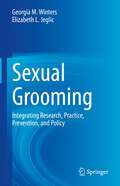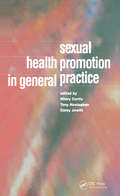- Table View
- List View
Sex-Based Differences in Lung Physiology (Physiology in Health and Disease)
by Patricia Silveyra Xenia T. TignoThis book provides an overview of the latest experimental work on sex-based differences in lung function and inflammation. Readers will learn how these differences relate to individual predispositions for the development of lung disease in men and women, and in different stages of their reproductive lives. Further, the book focuses on diseases that predominantly affect women or men, with an emphasis on the physiological mechanisms underlying their pathobiology. In turn, these findings are complemented by chapters on recent studies, which investigate how circulating sex hormone levels impact the lung’s innate immune response to environmental agents and air pollution. The pathogeneses of asthma and viral respiratory infection are also major focus areas. As an outlook, the book also discusses current and future research directions aimed at developing sex-specific therapies for lung disease. To examine these anatomical and physiological differences in the male and female respiratory systems, the authors employ a broad range of methods from molecular and clinical biology. Accordingly, the book will be a fascinating read for physiologists and clinicians alike.
Sex-Related Homicide and Death Investigation: Practical and Clinical Perspectives, Second Edition (Practical Aspects of Criminal and Forensic Investigations)
by Vernon J. GeberthRemember: Do it right the first time. You only get one chance.Vernon J. Geberth, M.S., M.P.S., 1980, Homicide and Forensic Consultant, Author of Practical Homicide Investigation and the Series Editor of Practical Aspects of Criminal and Forensic Investigations.In Practical Homicide Investigation, renowned author and investigator Vernon J. Gebert
Sex-Selective Abortion in India: Gender, Society and New Reproductive Technologies
by Tulsi PatelThis collection of 11 essays unravels the reasons for the depleting child sex ratio in India. The contributors, all distinguished demographers and social scientists, describe the political economy of sentiments and sexual mores that leads parents to kill unborn daughters. The contributors examine ways in which reproductive technologies, such as, the ultrasound, are misused at the family, community and state levels. In this alarming scenario, the volume highlights both the participation and defiance of the various authorities dealing with reproduction, health services and the problem of female foeticide. Engagement with the state is analysed in the light of colonial policies, the law of adoption, health policies, family planning programmes and the Pre-natal Diagnostic Techniques (PNDT) Act of 1994 and its amendment in 2002. Applying a multidisciplinary perspective to the problem of fewer girls being born in India, this volume addresses this critical issue with the help of qualitative and quantitative data, both historical and contemporary.
Sex-Specific Analysis of Cardiovascular Function (Advances in Experimental Medicine and Biology #1065)
by Peter L. Kerkhof Virginia M. MillerThis book gathers together contributions from internationally renowned authors in the field of cardiovascular systems and provides crucial insight into the importance of sex- and gender-concepts during the analysis of patient data. This innovative title is the first to offer the elements necessary to consider sex-related properties in both clinical and basic studies regarding the heart and circulation on multiscale levels (i.e. molecular, cellular, electrophysiologically, neuroendocrine, immunoregulatory, organ, allometric, and modeling). Observed differences at (ultra)cellular and organ level are quantified, with focus on clinical relevance and implications for diagnosis and patient management. Since the cardiovascular system is of vital importance for all tissues, Sex-Specific Analysis of Cardiovascular Function is an essential source of information for clinicians, biologists, and biomedical investigators. The wide spectrum of differences described in this book will also act as an eye-opener and serve as a handbook for students, teachers, scientists and practitioners.
Sex-Specific Reporting of Scientific Research
by Institute of Medicine Board on Population Health and Public Health Practice Theresa M. WizemanThe number of women participating in clinical trials has increased during the last two decades, but women are still underrepresented in clinical trials in general. Some of the overall increase can be attributed to the greater number of women-only trials (of therapies for diseases that affect only women). Even when women are included in clinical trials, the results are often not analyzed separately by sex. On August 30, 2011, the Institute of Medicine (IOM) Board on Population Health and Public Health Practice hosted the workshop Sex-Specific Reporting of Scientific Research. The workshop explored the need for sex-specific reporting of scientific results; potential barriers and unintended consequences of sex-specific reporting of scientific results; experiences of journals that have implemented sex-specific requirements, including the challenges and benefits of such editorial policies; and steps to facilitate the reporting of sex-specific results. Presenters and participants included current and former editors of scientific journals, researchers, and scientists and policymakers from government, industry, and nonprofit organizations. Presentations and discussions highlighted the importance to both women and men of having sex-specific data, the problems with sample size and financial constraints for conducting the research, the appropriateness of sex-specific analyses, and the limitations of journal policies to change experimental designs. Sex-Specific Reporting of Scientific Research summarizes the presentations and discussions by the expert panelists during the IOM workshop. The workshop's first session focused on why sex-specific reporting is important. Panelists highlighted historical and current events that have hindered or helped to advance the study of women. In the next session, panelists in academe discussed the challenges of collecting, analyzing, and reporting sex-specific data from the researcher's perspective. That was followed by two panels of leading journal editors who shared their experiences in developing and implementing editorial policies and the implications of sex-specific reporting policies for journals.
Sex/Gender-Specific Medicine in Clinical Areas
by Nayoung KimSex/gender-specific medicine (SGM) is defined as the practice of medicine based on the understanding that biology and social roles are important in men and women for prevention, screening, diagnosis, and treatment. Current research demonstrates differences in disease incidence, symptomatology, morbidity, and mortality depending on sex and gender. Sex/gender-specific medicine is a fundamental aspect of tailored therapy and precision medicine. Therefore, the variables must be considered in medical education and practice as well as in research models ranging from human participants, animals and cells. This concept could be applied in the whole clinical areas from Neuroscience, Psychiatry, Gastroenterology, Cardiology, and Rehabilitation, etc. Nowadays estrogen is known to play a key role in the prevention of colon cancer and in the resistant progression of liver cirrhosis and hepatocellular carcinoma, especially in women. This book covers the sex/gender-specific medicine in the whole clinical areas in the adults as well as in the pediatrics. In addition, research results of basic science are also introduced in the colon cancer and Alzheimer’s disease.
Sex/Gender-Specific Medicine in the Gastrointestinal Diseases
by Nayoung KimSex/gender - specific medicine (SGM) is defined as the practice of medicine based on the understanding that biology and social roles are important in men and women for disease prevention, screening, diagnosis, and treatment. Current research demonstrates differences in disease incidence, symptomatology, morbidity, and mortality based on sex and gender. Sex/gender-specific medicine is a fundamental aspect of tailored therapy and precision medicine. Therefore, the variables must be considered in medical education and practice as well as in research models ranging from human participants, animals and cells. Gastroenterology is very big and important division of Internal Medicine, which include esophagus, stomach, small and large intestine, pancreatobiliary tract and liver. Nowadays estrogen is known to play a key role in the prevention of colon cancer and progression of liver cirrhosis and hepatocellular carcinoma, especially in women. This book covers the sex/gender-specific medicine in the area of gastrointestinal (GI) tract in the adults as well as in the pediatrics and in the gut microbiota.
Sexual Abuse Litigation: A Practical Resource for Attorneys, Clinicians, and Advocates
by Rebecca A RixPrepare a solid case with advice from successful litigators!Ideal for use as a legal guide or a practical reference, Sexual Abuse Litigation examines how professionals can responsibly and effectively advocate on behalf of adult survivors of child sexual abuse (CSA) in the midst of the controversies surrounding recovered memories. This comprehensive book places the current recovered-memory controversy in historical context and examines how various psychological and medical conceptions of trauma have shaped public opinion and the construction of delayed discovery statutes of limitations. For lawyers, advocates, clinicians, and CSA survivors, Sexual Abuse Litigation offers practical advice in clear prose and an easy-to-use format. Summaries, charts, legal practice tips, and samples of actual testimony make this book an invaluable reference tool. It also tabulates the statutes of limitations for sexual abuse cases in all fifty states. In Sexual Abuse Litigation, experienced litigators will guide you through the phases of the legal process, offering practical suggestions on: case evaluation and development the pitfalls and opportunities of professional cooperation between therapists and lawyers the effective use of plaintiff expert witnesses strategies for countering the ”false memories” defense the identification of insurance benefits for injuries related to CSA techniques for cross-examining expert witnesses for the defense vital networking information, including resource referrals for adult survivors, help with appellate cases, and information on abuse by clergy and other professionalsOffering strategies for sustaining the admissibility of the CSA survivor's testimony and how to maintain focus on the question of whether abuse occurred, Sexual Abuse Litigation will give you or your client the necessary information on how to successfully prepare for a CSA case and face the challenges of such cases in the courtroom.
Sexual Behaviour and HIV/AIDS in Europe: Comparisons of National Surveys (Routledge Revivals)
by Michel Hubert; Nathalie Bajos; Theo SandfortOriginally published in 1998 Sexual Behaviour and HIV/AIDS in Europe is detailed study comparing the major population surveys on sexual behaviour and HIV/AIDS carried out in Europe at the time of publication. Leading European researchers explore the differences and similarities between European countries in patterns of sexual behaviour and responses to the HIV/AIDS epidemic. As well as providing an empirical and methodological base for future research, the comparative analyses lead researchers, policy makers, health-educators and the media to new insights and a deeper understanding of issues that are of central concern in many countries. The chapters include discussion of data on sexual initiation, homosexual and bisexual behaviour, sexual practices, sexual partners, risk behaviour, STDs, preventive practices, the normative context, knowledge of HIV/AIDS, and attitudes towards people with HIV/AIDS. The book results from a major European Concerted Action, funded by the European Union Biomedical and Health Research programme (BIOMED), and coordinated by the Centre d'Etudes Sociologiques of the Facultes Universitaires Saint-Louis, Brussels, Belgium. It follows Sexual Interactions and HIV Risk, published in 1997.
Sexual Behaviour and Health in Older Adults (Practical Issues in Geriatrics)
by Lee Smith Igor GrabovacThis book provides a comprehensive overview for those interested in research and promoting sexual health in older people, as well as a “go-to” guide on the topic of sexual behaviour in older adults. Sexual activity is an essential part of intimate relationships, though it tends to decline in frequency as people grow older. Nevertheless, for many older people, sex still remains an important part of their life. There’s a common misconception that as people age, they lose their interest in sex and capacity for sexual behaviour. This is not the case, as a number of national surveys show. The new research presented here indicates that the less sex older people have, the more likely they are to experience mental and physical health problems. Men and women who reported a decrease in the frequency of sexual activities were also more likely to report a deterioration in self-perceived health. Additionally, men with erectile dysfunction were also more likely to be diagnosed with cancer or coronary heart disease. This research has also determined that older adults who experience a decline in sexual activity report poorer well-being than those who maintain their levels of sexual desire, activity and function in later life, and that men who remain sexually active in later life continue to have better cognitive performance compared to those who don’t. Despite these health benefits, medical professionals do little to promote sexual activity in older adults, and the literature suggests that there is a lack of knowledge on how to approach the subject and how to promote such activities. This is the first comprehensive book specifically exploring all areas of sexual behaviour and health in older adults, and drawing on the latest research in this area. It offers a valuable resource for researchers and clinicians in various health fields (medicine, nursing, occupational therapy, psychology, public health, etc.), as well as students in undergraduate and graduate programs.
Sexual Chemistry
by Lara V. MarksMarks (former senior research fellow, history of 20th-century medicine, Imperial College) traces the origins of the pill to the Mexican yam plant, the American organic chemist, Russell Marker, and to scientists fleeing Europe for America during WWII. According to Marks, the novelty of the pill that it was separated in time from intercourse, that women could use it secretly, and that it molded perceptions that women were to take responsibility for birth control set the standards for forms of contraception that followed. The pill, one of the most investigated drugs in history, has been blamed as a creation by males to control females and use them as test subjects. But, says Marks, "This criticism not only ignores the historical context in which the pill was developed" but also the fact that "the research on the pill was both initiated and funded by women." Marks's research, partly based on new primary sources and oral interviews with key figures in the pill's history, yields an academic history with popular aspirations. Annotation c. Book News, Inc. , Portland, OR (booknews. com)
Sexual Crime and Trauma (Sexual Crime)
by Nicholas Blagden Belinda Winder Kerensa Hocken Rebecca Lievesley Phil Banyard Helen SwabyThis book explores the growing understanding and evidence base for the role of trauma in sexual offending. It represents a paradigm shift, in which trauma is becoming an important risk factor to be considered in the treatment of individuals convicted of sexual crime. The authors consider the theoretical and historical explanations and understandings of sexual offending and its relationship with early trauma, paving the way for a volume which considers client’s treatment needs through a new, trauma-informed lens. The experiences and challenges of specific groups are also explored, including young people and women. Readable, yet firmly anchored in a sound evidence base, this book is relevant to psychologists, therapists, criminologists, psychiatrists, mental health nurses, social workers, students, and to practitioners and the general public with an interest in learning more about the topic.
Sexual Crime, Religion and Spirituality (Sexual Crime)
by Nicholas Blagden Belinda Winder Helen Elliott Kerensa Hocken Rebecca Lievesley Phil BanyardThis book offers a collection of original contributions to the literature on sexual crime, religion and spirituality. Does religion help people desist from sexual crime? Can it form the basis of interventions to rehabilitate people? Or does it provide justification and opportunity for committing it? What do the perpetrators say about their faith? What about the victims and survivors of sexual crime? The book asks and answers these questions and more in a unique collection of chapters – from academics, chaplains and prisoners. The book begins with an exploration of the role, history and development of chaplaincy in the prison system over the years, before providing a more personal look through the eyes of the Lead Chaplain at Rampton High Secure hospital in the UK. Subsequent chapters weave together theories of desistance from sexual crime, and analyses of perpetrators’ accounts of their offending are also offered, alongside firsthand accounts of prisoners from a range of religions. The book concludes with a thoughtful journey through the book by the Lead Chaplain at HMP Stafford, UK. It will provide fresh insights for students and scholars of psychology, criminology, theology and social work, as well as for practitioners, chaplains, and readers with an interest in learning about sexual crime, religion and spirituality.
Sexual Deviance, Second Edition
by D. Richard Laws William T. O'DonohueNow in a fully revised and updated second edition, this important work provides authoritative scientific and applied perspectives on the full range of paraphilias and other sexual behavior problems. For each major clinical syndrome, a chapter on psychopathology and theory is followed by a chapter on assessment and treatment. Challenges in working with sex offenders are considered in depth. Thoroughly rewritten to reflect a decade of advances in the field, the second edition features many new chapters and new authors. New topics include an integrated etiological model, sexual deviance across the lifespan, Internet offenders, multiple paraphilias, neurobiological processes, the clinician as expert witness, and public health approaches.
Sexual Deviance: Understanding and Managing Deviant Sexual Interests and Paraphilic Disorders
by Leam A. Craig Ross M. BartelsSEXUAL DEVIANCE The essential text for understanding and managing deviant sexual interest and paraphilic disorders Sexual Deviance is an authoritative text that provides an understanding to the assessment, management, and treatment of sexual deviance and paraphilic disorders. The international panel of contributors—noted experts on the topic—illuminate the emerging theories that help to explain the developmental influences and pathways of sexual deviance and its connection to offending behaviour. The text considers various developmental influences such as neurobiological pathways as well as the effects of pornography. The contributors highlight the assessment and diagnosis of sexual deviance and explore the links to offending behavior such as rape fantasy, algolagnic paraphilia, online viewing of indecent images of children, and sexual sadism. The book examines the effectiveness of a variety of current treatments including behavioral, pharmacological, cognitive behavioral therapy, and systemic treatment. This important text: Offers contributions from an international panel of expertsExamines the causes of deviant sexual interestsPresents techniques for managing deviant sexual interestsIncludes information on co-morbid disorders and sexual offending Written for students and professionals in psychology, criminology, psychiatry, forensic nursing, and social work, Sexual Deviance explores deviant sexual interests in sexual offenders and reviews the techniques designed to manage behavior.
Sexual Differentiation of the Brain (CRC Press Revivals)
by Akira MatsumotoSexual difference in the brain has long been one of the more intriguing research areas in the field of neuroscience. This thorough and comprehensive text uncovers and explains recent neurobiological and molecular biological studies in the field of neuroscience as they relate to the mechanisms underlying sexual differentiation of the brain.Attempts have been made to clarify sex differences in the human brain using noninvasive techniques such as magnetic resonance imaging. Sexual Differentiation of the Brain thoroughly examines these techniques and findings, providing an up-to-date, comprehensive overview written by leading researchers in the field.Just a few of the topics addressed include genetic contributions to the sexual differentiation of behavior; in-vitro studies of the effects of estrogen on estrogen receptor-transfected neuroblastoma cells; and the evolution of brain mechanisms controlling sexual behavior. Other topics include sexual differentiation of neural circuitry in the hypothalamus; structural sex differences in the mammalian brain; and sexual differentiation of cognitive functions in humans.With its revealing and informative chapters, as well as provocative treatment of the subject matter, Sexual Differentiation of the Brain helps shed new light on one of the most fascinating areas of brain research.
Sexual Dysfunction, Second Edition
by Michael P. Carey Michael P. WinczeAn ideal introduction for sex therapy students and trainees, this volume provides an overview of the most common sexual dysfunctions and the full range of assessment and treatment approaches. The book begins with discussions of the main classes of sexual dysfunction, describing what is currently known about clinical presentation, prevalence, and etiological factors. Addressing the practical tasks of clinical evaluation and intervention, the authors clearly explain basic strategies and methods for working with clients.
Sexual Enhancers From Nature
by Dr Angela FetznerAs you will read in this guidebook, it does not always have to be the blue pills, there are numerous mild yet safe herbal sexual enhancers. As you will read in this guidebook, it does not always have to be the blue pills, there are numerous mild yet safe herbal sexual enhancers. Many of the herbal sexual enhancers have been around for a long time in the often faraway countries of origin and their potency-enhancing effect has been used there for ages - but it is only gradually that these herbal sexual enhancers are also conquering the European market. Behind the desire for herbal sexual enhancers is, of course, also the desire not to have to "work off" the sexual act with a chemical pill, but deep inside us we carry the desire for a holistic sexuality - mysterious, unique, and mystical. And this is where love plants can start: These strengthen not only the potency, but awaken all the senses and can help to reduce stress and really relax again. If we take this to heart, our love life becomes (again) fulfilling and mysterious.
Sexual Forensics in Victorian and Edwardian England: Age, Crime and Consent in the Courts (Genders And Sexualities In History Ser.)
by Victoria BatesDrawing on court records from London and the South West, Sexual Forensics in Victorian and Edwardian England explores medical roles in trials for sexual offences. Its focus on sexual maturity, a more flexible concept than the legal age of consent, enables histories of sexual crime to be seen in a new light.
Sexual Function and Pelvic Floor Dysfunction: A Guide for Nurses and Allied Health Professionals
by Angie RantellThis book provides to nurses an understanding of female sexual function and dysfunction specifically in relation to common gynecological conditions. It offers evidence based overview of assessment of sexual function, including available questionnaires and provides a multidisciplinary approach to managing sexual dysfunction, from incontinence to pelvic organ prolapse and recurrent urinary tract infections. It also covers a holistic approach including over the counter and home treatments, psychological therapies, physical therapies, pharmacological options and if necessary more invasive interventions. Sexual function and pelvic floor dysfunction is often a neglected area due to the taboo nature of discussions. This book aims to educate nurses, to help them understand the types of treatment options available, and encourage them to engage in conversations about sexual function with women, so that they can be referred to appropriate health professionals and access the right care.
Sexual Function in the Prostate Cancer Patient
by John P MulhallSexual dysfunction presents a major challenge to physicians who take on the task of treating men with prostate cancer. While curing the disease and saving a life is paramount, improving technologies and therapies offer skilled surgeons and clinical oncologists the opportunity to eradicate the disease without compromising sexual function. In Sexual Function of the Prostate Cancer Patient, John Mulhall and a panel of internationally recognized experts on prostate cancer and sexual function assess in detail the current state of prostate cancer treatment. The authors offer a broad overview of the pathophysiology and treatment of erectile dysfunction in men with prostate cancer, reviewing the latest findings regarding erection-sparing radiation therapy and sexual function outcomes after laparascopic and robotic prostatectomy. Additional chapters discuss intra-operative maneuvers to minimize post-operative erectile dysfunction and pharmacologic penile preservation and rehabilitation. Timely and authoritative, Sexual Function in the Prostate Cancer Patient is a highly readable guide to preserving post-prostate cancer sexual function that no urologist or radiation and medical oncologist should be without.
Sexual Grooming: Integrating Research, Practice, Prevention, and Policy
by Elizabeth L. Jeglic Georgia M. WintersThis book provides an in-depth overview of the current research on sexual grooming. It explores the process by which an individual seeking to commit a sexual offense skillfully manipulates a potential victim into situations in which abuse can be more readily committed, while simultaneously preventing disclosure and detection. This volume addresses this understudied phenomenon and comprehensively examines what is currently known about the construct. It provides a thorough introduction to the sexual grooming literature, focusing on the history of the term and how sexual grooming strategies have become more publicly recognized through high-profile cases, as well as those in child-serving organizations (e.g., Catholic Church, Boy Scouts of America). The book reviews the various proposed models of sexual grooming – including the Sexual Grooming Model (SGM) – that detail the overarching steps or stages involved in the process. It discusses attempts to define the construct of sexual grooming and addresses potential consequences of sexual grooming, emphasizing how victims, families, and communities at large may be affected.Key areas of coverage include: Unique contexts and facets in which sexual grooming behavior has been observed, including online grooming, personal/self-grooming, familial grooming, institutional grooming, and grooming behaviors of females. The ways in which sexual grooming strategies may be manifested in sex trafficking cases and in adult sexual abuse. Assessment and treatment of sexual grooming, as well as prevention strategies. The implementation of grooming research to inform law enforcement efforts and court decision-making. The creation and adoption of legislation and policies designed to prevent sexual grooming. Child Sexual Grooming is an essential resource for researchers, professors, graduate students, clinicians, mental health therapists, legal professionals, policy makers, law enforcement, and related professionals in developmental psychology, child and adolescent psychology, social work, public health, criminology/criminal justice, forensic psychology, and behavioral therapy and rehabilitation.
Sexual Health Promotion in General Practice
by Hilary CurtisSexual Health Promotion in General Practice provides a menu of options and ideas to meet the wide variety of needs in both urban and rural practices and those serving populations with different prevalences of HIV and sexually transmitted diseases. The book therefore reflects the strategy of The Health of the Nation. It can be used as a practical manual for developing practice policies and as a text for individual reference by the entire primary care team. Published in association with the BMA Foundation for AIDS The HIV Project and Camden & Islington Community Health Services NHS Trust
Sexual Health and Genital Medicine in Clinical Practice
by Christopher SonnexThis fully revised and updated second edition of Sexual Health and Genital Medicine in Clinical Practice covers the range of conditions seen in genitourinary medicine, sexual health and sexually transmitted infection clinics, making it a useful and practical guide to all health practitioners in this area. This book is aimed at medical practitioners who require a quick reference guide to help with diagnosis and management of genital problems. In addition, it provides essential guidance on what to do next when faced with a patient presenting with a genital complaint, whether the patient can be successfully treated with a drug regimen or needs to be referred up to the Sexual Health and Genital Medicine specialist. Sexual Health and Genital Medicine in Clinical Practice will be of particular interest to residents on their rotations through this field of medicine, doctors in training, specialist nurses, and primary care practitioners.
Sexual Health and The Menopause
by Margaret Rees Tony Mander John M TomlinsonPublished on behalf of the British Menopause Society, this is a practical and sensitive collection of articles on common sexual health issues which concern menopausal women and their partners. Many older women have an increased sexual response owing to a reduced fear of pregnancy, the end of menstrual distress and no longer needing contraception; however, with increased age comes associated sexual problems for both men and women.Edited and written by leading specialists, each chapter is a minimum of 1500 words plus 10-15 up-to-date references for further reading. This book is recommended to GPs, nurses, and all professionals working in family planning and genitourinary medicine.

